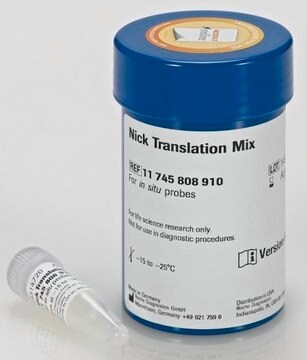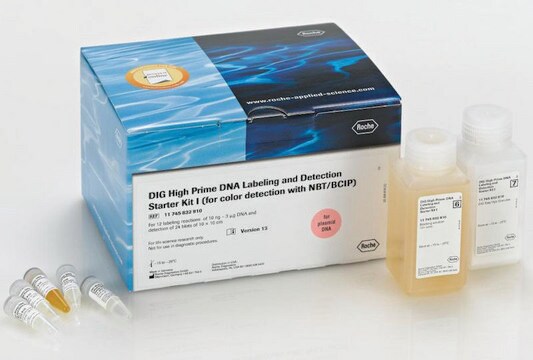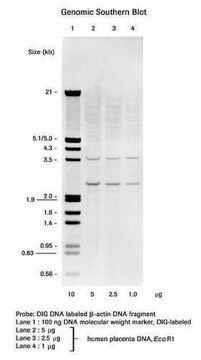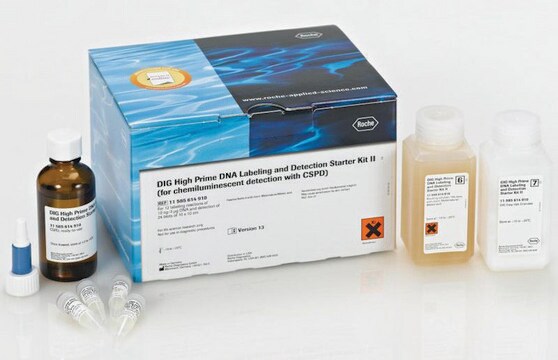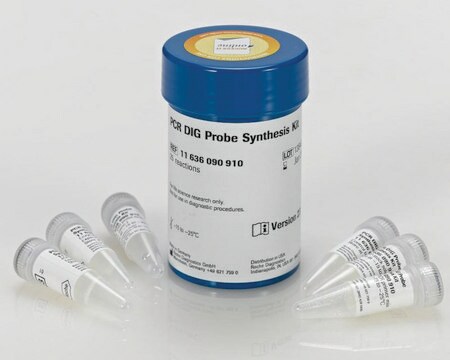11745816910
Roche
DIG-Nick Translation Mix
sufficient for 40 labeling reactions, pkg of 160 μL, suitable for hybridization
Sinonimo/i:
nick translation
About This Item
Prodotti consigliati
Forma fisica
solution
Livello qualitativo
impiego
sufficient for 40 labeling reactions
Confezionamento
pkg of 160 μL
Produttore/marchio commerciale
Roche
Caratteristiche più verdi
Designing Safer Chemicals
Learn more about the Principles of Green Chemistry.
sustainability
Greener Alternative Product
tecniche
hybridization: suitable
Categoria alternativa più verde
, Aligned
Temperatura di conservazione
−20°C
Descrizione generale
Specificità
Applicazioni
Note: The mix can also be used for filter hybridization techniques, however, for highly sensitive filter hybridization probes, we recommend that you use DIG-High Prime from Roche Applied Science.
For nonradioactive labeling of in situ probes with other haptens and fluorophores, Roche Applied Science offers the Biotin-Nick Translation Mix and the Nick Translation Mix (without nucleotides).
Qualità
Principio
E. coli DNA Polymerase I synthesizes DNA complementary to the intact strand in a 5′→3′ direction using the 3′-OH termini of the nick as a primer. The 5′→3′ exonucleolytic activity of DNA polymerase I simultaneously removes nucleotides in the direction of synthesis. The polymerase activity sequentially replaces the removed nucleotides with isotope-labeled or hapten-labeled deoxyribonucleoside triphosphates. At low temperature (+15°C), the unlabeled DNA in the reaction is thus replaced by newly synthesized labeled DNA.
Nota sulla preparazione
Assay Time: 100 minutes
Sample Materials: Supercoiled and linearized plasmid DNA, Supercoiled and linearized cosmid DNA, Purified PCR products.
Note: Denaturing of the template before nick translation is not required.
Altre note
Codice della classe di stoccaggio
12 - Non Combustible Liquids
Classe di pericolosità dell'acqua (WGK)
WGK 1
Punto d’infiammabilità (°F)
No data available
Punto d’infiammabilità (°C)
No data available
Certificati d'analisi (COA)
Cerca il Certificati d'analisi (COA) digitando il numero di lotto/batch corrispondente. I numeri di lotto o di batch sono stampati sull'etichetta dei prodotti dopo la parola ‘Lotto’ o ‘Batch’.
Possiedi già questo prodotto?
I documenti relativi ai prodotti acquistati recentemente sono disponibili nell’Archivio dei documenti.
I clienti hanno visto anche
Articoli
Digoxigenin (DIG) labeling methods and kits for DNA and RNA DIG probes, random primed DNA labeling, nick translation labeling, 5’ and 3’ oligonucleotide end-labeling.
Il team dei nostri ricercatori vanta grande esperienza in tutte le aree della ricerca quali Life Science, scienza dei materiali, sintesi chimica, cromatografia, discipline analitiche, ecc..
Contatta l'Assistenza Tecnica.
